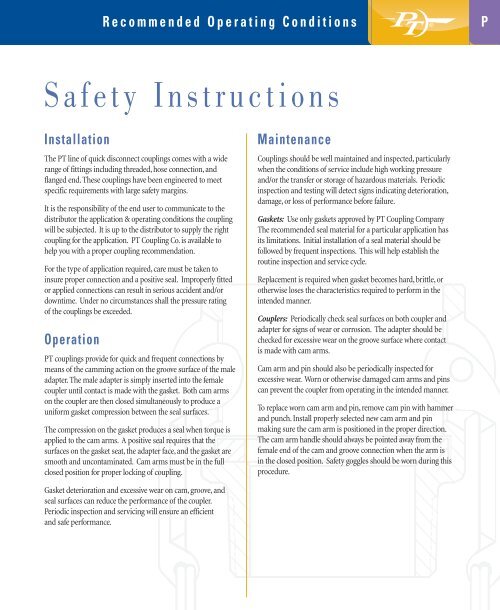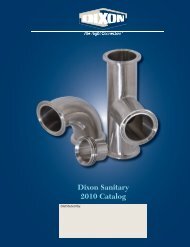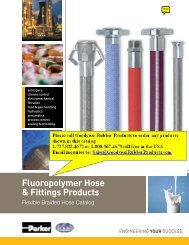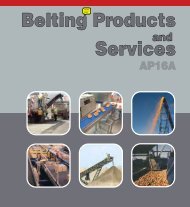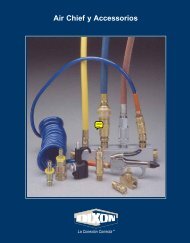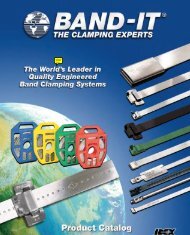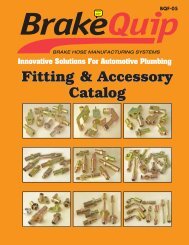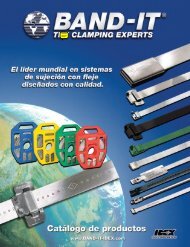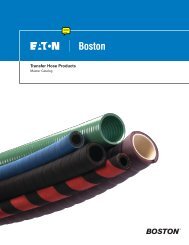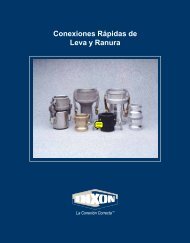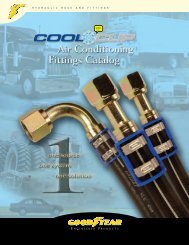PT Coupling
PT Catalog - Goodyear
PT Catalog - Goodyear
- No tags were found...
Create successful ePaper yourself
Turn your PDF publications into a flip-book with our unique Google optimized e-Paper software.
R e c o m m e n d e d O p e r a t i n g C o n d i t i o n s<br />
P<br />
S a f e t y I n s t r u c t i o n s<br />
Installation<br />
The <strong>PT</strong> line of quick disconnect couplings comes with a wide<br />
range of fittings including threaded, hose connection, and<br />
flanged end. These couplings have been engineered to meet<br />
specific requirements with large safety margins.<br />
It is the responsibility of the end user to communicate to the<br />
distributor the application & operating conditions the coupling<br />
will be subjected. It is up to the distributor to supply the right<br />
coupling for the application. <strong>PT</strong> <strong>Coupling</strong> Co. is available to<br />
help you with a proper coupling recommendation.<br />
For the type of application required, care must be taken to<br />
insure proper connection and a positive seal. Improperly fitted<br />
or applied connections can result in serious accident and/or<br />
downtime. Under no circumstances shall the pressure rating<br />
of the couplings be exceeded.<br />
Operation<br />
<strong>PT</strong> couplings provide for quick and frequent connections by<br />
means of the camming action on the groove surface of the male<br />
adapter. The male adapter is simply inserted into the female<br />
coupler until contact is made with the gasket. Both cam arms<br />
on the coupler are then closed simultaneously to produce a<br />
uniform gasket compression between the seal surfaces.<br />
The compression on the gasket produces a seal when torque is<br />
applied to the cam arms. A positive seal requires that the<br />
surfaces on the gasket seat, the adapter face, and the gasket are<br />
smooth and uncontaminated. Cam arms must be in the full<br />
closed position for proper locking of coupling.<br />
Maintenance<br />
<strong>Coupling</strong>s should be well maintained and inspected, particularly<br />
when the conditions of service include high working pressure<br />
and/or the transfer or storage of hazardous materials. Periodic<br />
inspection and testing will detect signs indicating deterioration,<br />
damage, or loss of performance before failure.<br />
Gaskets: Use only gaskets approved by <strong>PT</strong> <strong>Coupling</strong> Company<br />
The recommended seal material for a particular application has<br />
its limitations. Initial installation of a seal material should be<br />
followed by frequent inspections. This will help establish the<br />
routine inspection and service cycle.<br />
Replacement is required when gasket becomes hard, brittle, or<br />
otherwise loses the characteristics required to perform in the<br />
intended manner.<br />
Couplers: Periodically check seal surfaces on both coupler and<br />
adapter for signs of wear or corrosion. The adapter should be<br />
checked for excessive wear on the groove surface where contact<br />
is made with cam arms.<br />
Cam arm and pin should also be periodically inspected for<br />
excessive wear. Worn or otherwise damaged cam arms and pins<br />
can prevent the coupler from operating in the intended manner.<br />
To replace worn cam arm and pin, remove cam pin with hammer<br />
and punch. Install properly selected new cam arm and pin<br />
making sure the cam arm is positioned in the proper direction.<br />
The cam arm handle should always be pointed away from the<br />
female end of the cam and groove connection when the arm is<br />
in the closed position. Safety goggles should be worn during this<br />
procedure.<br />
Gasket deterioration and excessive wear on cam, groove, and<br />
seal surfaces can reduce the performance of the coupler.<br />
Periodic inspection and servicing will ensure an efficient<br />
and safe performance.


